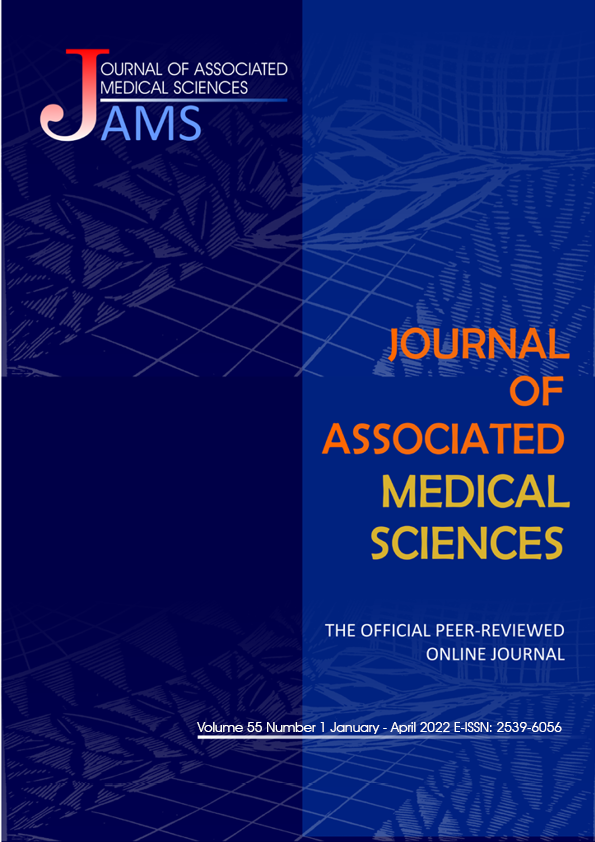Survey of photoneutron emitted from 6MV, 10MV, and 15MV medical LINAC using nuclear track detection
Main Article Content
Abstract
Background: Medical linear accelerators (LINAC) can produce unwanted photoneutrons that might cause tissue damage or cancer in other organs. The efficient techniques and detectors are importantly required to detect these harmful neutrons.
Objectives: This study aimed to measure photoneutrons produced from medical LINAC of 6, 10, and 15 megavolts (MV).
Materials and methods: Nuclear track detector (CR-39 detectors) were employed to quantify the number of neutrons from LINACs. The X-ray energies, doses, and radiation techniques were varied to compare the number of neutrons. The photoneutron productions inside the LINAC room were also examined.
Results: The results showed that there were no neutrons from medical LINAC 6 MV, whereas photoneutrons could be detected from 10 and 15 MV LINAC. Radiotherapeutic techniques with moving multi-leaf collimator (MLC) produced higher photoneutron than techniques without using MLC. The neutrons were detected on the walls of the LINAC room.
Conclusion: X-ray energy greater than 10 MeV generated undesired photoneutrons that can penetrate the shielding and increase the patient dose. For the safety of staff to re-enter the treatment room, delaying time should be considered for the neutron decay process.
Article Details

This work is licensed under a Creative Commons Attribution-NonCommercial-NoDerivatives 4.0 International License.
Personal views expressed by the contributors in their articles are not necessarily those of the Journal of Associated Medical Sciences, Faculty of Associated Medical Sciences, Chiang Mai University.
References
Sung H, Ferlay J, Siegel RL, Laversanne M, Soerjomataram I, Jemal A, et al. Global cancer statistics 2020: GLOBOCAN estimates of incidence and mortality worldwide for 36 cancers in 185 countries. CA Cancer J Clin. 2021; 71(3): 209-49.
Facure A, Falcão RC, Silva AX, Crispim VR, Vitorelli JC. A study of neutron spectra from medical linear accelerators. Appl Radiat Isot. 2005; 62(1): 69-72.
Khaled NE, Attalla EM, Ammar H, Khalil W. Dosimetry and fast neutron energies characterization of photoneutrons produced in some medical linear accelerators. Radiat Eff Defect S. 2011; 166(12): 908-17.
Naseri A, Mesbahi A. A review on photoneutrons characteristics in radiation therapy with high-energy photon beams. Rep Pract Oncol Radiother. 2010; 15(5): 138-44.
Powell NL, Newing A, Bullen MA, Sims C, Leaton SF. A radiation safety survey on a Clinac-20 linear accelerator. Phys Med Biol. 1987; 32(6): 707-18.
Podgoršak EB. Radiation Physics for Medical Physicists 3rd Ed. Berlin: Springer; 2016.
Yücel H, Çobanbaş İ, Kolbaşı A, Yüksel AÖ, Kaya V. Measurement of photo-neutron dose from an 18-mv medical linac using a foil activation method in view of radiation protection of patients. Nucl Eng Technol. 2016; 48(2): 525-32.
Mameli A, Greco F, Fidanzio A, Fusco V, Cilla S, D’Onofrio G, et al. CR-39 detector based thermal neutron flux measurements, in the photo neutron project. Nucl Instrum Methods Phys Res B. 2008; 266(16): 3656-60.
Banaee N, Goodarzi K, Nedaie HA. Neutron contamination in radiotherapy processes: a review study. J Radiat Res. 2021; 62(6): 947-54.
Kry SF, Salehpour M, Followill DS, Stovall M, Kuban DA, White RA, et al. Out-of-field photon and neutron dose equivalents from step-and-shoot intensity-modulated radiation therapy. Int J Radiat Oncol Biol Phys. 2005; 62(4): 1204-16.
Flores A, Palomino-Merino R, Espinosa E, Castaño V, Guzmán-gatica L, Espinosa G. Analysis and characterization of neutron scattering of a Linear Accelerator (LINAC) on medical applications. J Nucl Phy Mat Sci Rad A. 2017; 5: 65-78.
Ho L, White P, Chan E, Chan K, Ng J, Tam T. Evaluation of Optimum Room Entry Times for Radiation Therapists after High Energy Whole Pelvic Photon Treatments. J Occup Health. 2012; 54(2): 131-40.
Israngkul-Na-Ayuthaya I, Suriyapee S, Pengvanich P. Evaluation of equivalent dose from neutrons and activation products from a 15-MV X-ray LINAC. J Radiat Res. 2015; 56(6): 919-26.


